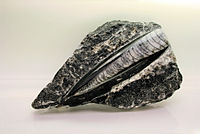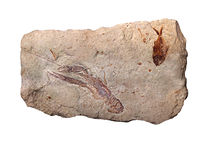Developments in interpretation of the fossil record
Ever since recorded history began, and probably before, people have noticed and gathered fossils, including pieces of rock and minerals that have replaced the remains of biologic organisms, or preserved their external form. Fossils themselves, and the totality of their occurrence within the sequence of Earth's rock strata, is referred to as the fossil record.
The fossil record was one of the early sources of data relevant to the study of evolution and continues to be relevant to the history of life on Earth. Paleontologistsexamine the fossil record in order to understand the process of evolution and the way particular species have evolved.
Explanations
Various explanations have been put forth throughout history to explain what fossils are and how they came to be where they were found. Many of these explanations relied on folktales or mythologies. In China the fossil bones of ancient mammals including Homo erectus were often mistaken for “dragon bones” and used as medicine and aphrodisiacs. In the West the presence of fossilized sea creatures high up on mountainsides was seen as proof of the biblical deluge.
Greek scholar Aristotle realized that fossil seashells from rocks were similar to those found on the beach, indicating the fossils were once living animals.Leonardo da Vinci concurred with Aristotle's view that fossils were the remains of ancient life.In 1027, the Persian geologist, Avicenna explained how thestoniness of fossils was caused in The Book of Healing. However, he rejected the explanation of fossils as organic remains.Aristotle previously explained it in terms of vaporous exhalations, which Avicenna modified into the theory of petrifying fluids (succus lapidificatus), which was elaborated on by Albert of Saxony in the 14th century and accepted in some form by most naturalists by the 16th century. Avicenna gave the following explanation for the origin of fossils from thepetrifaction of plants and animals:
If what is said concerning the petrifaction of animals and plants is true, the cause of this (phenomenon) is a powerful mineralizing and petrifying virtue which arises in certain stony spots, or emanates suddenly from the earth during earthquake and subsidences, and petrifies whatever comes into contact with it. As a matter of fact, the petrifaction of the bodies of plants and animals is not more extraordinary than the transformation of waters.
More scientific views of fossils emerged during the Renaissance. For example, Leonardo Da Vinci noticed discrepancies with the use of the biblical flood narrative as an explanation for fossil origins:
"If the Deluge had carried the shells for distances of three and four hundred miles from the sea it would have carried them mixed with various other natural objects all heaped up together; but even at such distances from the sea we see the oysters all together and also the shellfish and the cuttlefish and all the other shells which congregate together, found all together dead; and the solitary shells are found apart from one another as we see them every day on the sea-shores.
And we find oysters together in very large families, among which some may be seen with their shells still joined together, indicating that they were left there by the sea and that they were still living when the strait of Gibraltar was cut through. In the mountains of Parma and Piacenza multitudes of shells and corals with holes may be seen still sticking to the rocks...
William Smith (1769–1839), an English canal engineer, observed that rocks of different ages (based on the law of superposition) preserved different assemblages of fossils, and that these assemblages succeeded one another in a regular and determinable order. He observed that rocks from distant locations could be correlated based on the fossils they contained. He termed this the principle of faunal succession.
Smith, who preceded Charles Darwin, was unaware of biological evolution and did not know why faunal succession occurred. Biological evolution explains why faunal succession exists: as different organisms evolve, change and go extinct, they leave behind fossils. Faunal succession was one of the chief pieces of evidence cited by Darwin that biological evolution had occurred.
Georges Cuvier came to believe that most if not all the animal fossils he examined were remains of species that were now extinct. This led Cuvier to become an active proponent of the geological school of thought called catastrophism. Near the end of his 1796 paper on living and fossil elephants he said:
- All of these facts, consistent among themselves, and not opposed by any report, seem to me to prove the existence of a world previous to ours, destroyed by some kind of catastrophe.




No comments:
Post a Comment